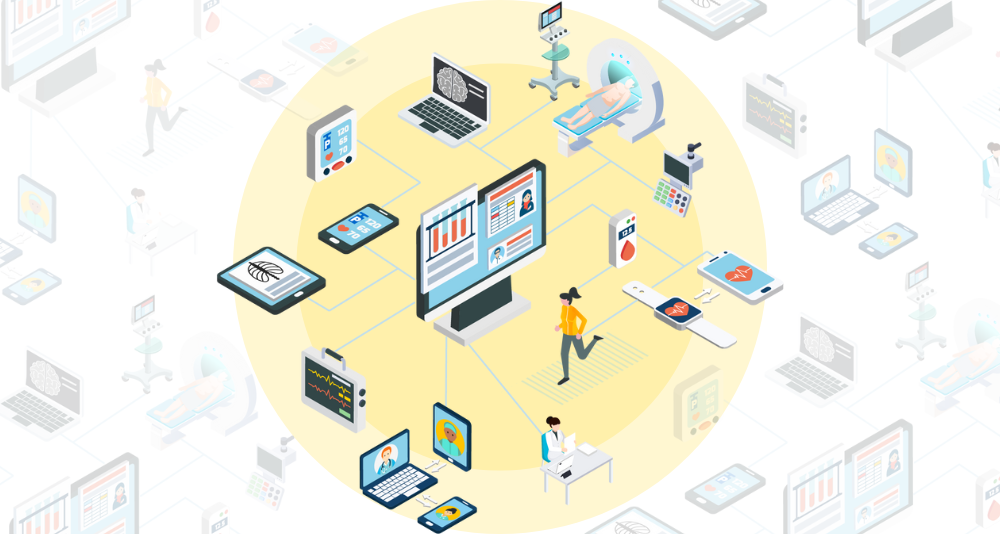This article is based on our recent webinar, "MedTech Evolution or Revolution: From Hospital-at-Home to Care Anytime, Anywhere", in which digital health experts from S3 Connected Health, Inspire Medical Systems, and Abbott discuss the core challenges the health industry faces as it moves toward connected medical devices that are part of a larger interoperable ecosystem.
Connectivity is at the center of the debate around the evolution of medical devices. MedTech companies are embracing digital health initiatives to extend the value of their offerings, but not everyone is convinced by technology's promise. The challenges are well-charted territory, from navigating governance and stringent regulations to usability and behavior change.
The reality is that globally, there's no longer the time or the luxury to dismiss the call for digital health solutions. The race is on to fulfill the vision of Hospital-at-home and Care Anytime, Anywhere. The drivers for change are compelling. Reports indicate a shortage of 10 million healthcare providers (HCPs) by 2030 and that 40% of doctors in the US have considered leaving the field. These numbers sound grim but indicate the extraordinary opportunity for MedTech to realize digital health's potential. Now is the time for healthcare systems to invest in a more sustainable model.
The healthcare industry must rewire to keep up with evolving technologies. As Bill Betten, Director of Solutions (MedTech) at S3 Connected Health, pointed out: "The technology is here. We're ready to go and be put to work on this. The challenge is how do we change the infrastructure to allow us to realize the value of digital health."
Understanding the medical device continuum
Historically, the device has been the center of the universe for medical device companies. As technology has evolved, many have partnered with MedTech companies to wrap technology around existing devices to provide data and insights; some have taken these insights further and begun building services.
Yet, the vision for the future of healthcare goes beyond even these critical steps. Industry leaders are focused on realizing truly connected health, where patients can access care regardless of location. Companies must consider whether hyper-focusing on medical devices will be enough to remain relevant in a competitive market.

The panelists shared three clear paths traditional medical device companies can take:
-
Remain a device vendor. The device is still the core innovation and the center of focus. The existing business model is still a viable approach. Medical device companies sell a product with a specific function and don't worry about the connected side of the equation.
-
Become a digital enabler. Medical device companies connect devices to gather information and data and provide it to clinicians or patients so that users can interact with it and provide insights.
-
Become a digital player. You can create an entire ecosystem that maximizes the value your medical device and digital health offerings bring.
Betten expanded on the digital player's role in healthcare: "This is the future state. The industry is moving from an isolated device operating independently to ubiquitous connectivity, where devices talk to one another."
The journey from acute to ubiquitous care
Our healthcare system currently excels at acute care. It's what we've done for over a century, and hospitals continue to treat patients suffering from acute conditions. Chronic, preventative, and episodic care have all improved with the advent of medical devices and pharmaceuticals.
Yet, most healthcare data remains isolated, preventing patients and clinicians from getting a complete picture. Ubiquitous care would mean a fully connected ecosystem that allows people to access the healthcare and information they need anytime, anywhere. This ecosystem would allow unprecedented access to critical information that could save lives.
.png?width=563&height=301&name=Advamed%20Blog%20Cover%20Image%20(1).png)
John Rondoni, Chief Technology Officer at Inspire Medical Systems, commented on the urgency for MedTech companies to architect these ecosystems. "If we don't build an ecosystem as a MedTech community, somebody else will do it. And that ecosystem will ultimately be an incredibly important part of the value creation in healthcare."
The challenges of device evolution for MedTech
In summarizing the barriers MedTech faces, Betten said: “This is very complex. It takes a lot of different people playing together to make all of this work. It's these barriers that have collaborated to keep digital health from really spreading. It's no longer that big of a technological challenge. But what we have to do is look at the infrastructure."
A brief audience poll illuminated the industry's challenges in realizing a fully connected healthcare ecosystem. Below, some of the results have been included alongside insights from the thought leaders.
Challenge #1 | Interoperability
67% of webinar participants chose connectivity and interoperability as one of the core challenges MedTech faces in moving forward. Each panelist offered further insight into the critical nature of the issue.
Betten explained the difficulties of getting devices to speak to each other in the current system, highlighting that the future ecosystem will depend on developing that capability. "Gathering and creating data is good, but we must pull that together. We need to organize it, structure it, and make it useful. The promise of digital health is that I can look at myself 24/7, 365 days a year, from several angles, but that doesn't do me any good if I have to open 5 apps to look at all of those different things."
Rondoni spoke to the potential of interoperability and the possibility of gleaning medical-grade insights from consumer-grade sensors on wearables. "It's a huge opportunity in the future to build these medical device layers on top of devices we use daily.
Dr. AJ Shah, Associate Director of Strategy & Innovation at Abbott, weighed in on the importance of interoperability in their current work. "Interoperability seems to come up more and more. We've entered into some innovative partnerships, integrating a Class 2 regulated medical device into consumer wearables and consumer health applications."
An example used to illustrate this work was Abbott's integration with WeightWatchers. Users of the WeightWatchers Diabetes Program can receive their CGM glucose data directly in their Weight Watchers experience. The algorithm pulls personalized insights from this data to generate relevant guidance for condition management.
Challenge #2 | Affordability and access
"Accessibility and affordability are always central to what we do. If we can't do that, then our devices only have limited impact at the end of the day," said Shah, referring to Abbott's use of the three Ds to guide decisions around solution development. Democratize, decentralize, and digitize: This means creating more accessible, personalized, and convenient products, delivering care where and when needed, and connecting people with timely, accurate, and actionable health information to ensure our technologies have the greatest impact.
Challenge #3 | Interpreting large amounts of data
One of the critical challenges will be interpreting voluminous amounts of data and making it meaningful. Shah used FreeStyle Libre as an example of how Abbott has successfully managed what has the potential to be a burdensome data load. "When we're collecting a glucose data point every minute, without contextualizing that and producing the right insights, it can be meaningless and burdensome to clinicians and caregivers."
Challenge #4 | Consumer-like usability
Bringing treatments normally conducted in a hospital into the home is rarely simple. Usability must be at the core of how medical devices are developed, considering the digital literacy of end-users and whether patients, caregivers, clinicians (or a mixture) will need to be able to use these often life-saving devices.
The IT infrastructure in hospitals is simply not realistic in a home setting, so something needs to be in place for when things don't go to plan. When we move to hospital-at-home, caregivers and patients are left to tackle technical glitches alone. Though companies don't necessarily want to focus on things going awry, they need to make it easy and seamless for users to get assistance.
The benefits of Hospital Anywhere
The conversation then turned to some benefits that effective Hospital Anywhere strategies provide. A brief audience poll illuminated the benefits of Hospital Anywhere for MedTech companies. Below, some of the results have been included alongside the main points from the panelists.
Benefit #1 | Improving patients' quality of life
78% of respondents to the poll believed the leading benefit of "Hospital Anywhere" was improving patients' quality of life. Studies have confirmed that patients' psychological well-being improves when treated in their home environment. Concurrently, the cost of care decreases. This reality should be a driver when it comes to managing patients with chronic disease states or at the end of life, where comfort is paramount, and hospital settings can cause mental distress or unnecessary anxieties.
Benefit #2 | Improving therapy effectiveness
70% of poll respondents selected "improving therapy effectiveness" as a core benefit MedTech companies can achieve. Shah spoke about the behavior changes medical devices can support and how this can lead to higher therapy engagement and adherence. Historically, medical devices and even pharmacological treatments might have had a ceiling regarding effectiveness, and it took a lot of work for clinicians to get a complete picture of the patient's progress along a treatment plan.
Now, with connected digital health solutions, clinicians can get answers that were not previously possible, and MedTech companies should develop medical devices that connect to a digital health platform that supports patients in unprecedented ways, whether this is through nudges or educational tools that might be part of the user interface and integrated treatment plan.
For even more insights, you can listen to the full webinar to learn about the journey to ubiquitous care, as well as the challenges and benefits discussed. Find out what panelists Bill Betten, Dr. AJ Shah, and John Rondini had to say about everything from interoperability to improving patients' quality of life.


